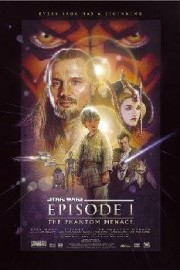Star Wars: The Phantom Menace
The most anticipated movie ever made, “Menace” is the beginning of Lucas’s prequel trilogy, which chronicles the early rise and fall of Anakin Skywalker (here played by Lloyd). In this chapter, Anakin is discovered by Qui-Gon Jinn (Neeson) and Obi-Wan Kenobi (McGregor) while trying to help the queen of the planet Naboo, Queen Amidala (Portman), free her people from the oppression of the Trade Federation. Along the way the trio pick up a Gungan warrior named Jar Jar Binks and a little robot by the name of R2-D2 (ring a bell anyone?). If I see one more review saying that this didn’t live up to the massive hype that came with it, even if it is true, I’m going to choke. No movie could have possibly lived up to this film’s extraordinary hype.
Nevertheless, writer-director Lucas (his first time in the director’s chair since the original “Star Wars”) has created an epic of staggering visual scope and narrative sweep, a film that matches up superbly with the original trilogy in his visionary adventure saga. With more effects than any other film in history, Lucas somehow retains the freshness of the series and keen eye for detail he (and his fellow directors) had in the first three films, creating new, fascinating worlds for us to inhabit and revisit in our imagination. Just try not be astonished when you see the Gungan’s Underwater City, a masterpiece of startling imagination; or having your breath be taken away by the sight of Naboo; or Coruscant, a city that covers an entire planet; or the stunning Senator’s chamber, which reminded me of the Strangers’s layer in Dark City, but went amazingly beyond that striking creation. Just as wondrous is the ominous passage through the planet core, with evocative music by the ever-great John Williams (who writes some of the best music of his career for “Menace”), where Jar Jar leads Qui-Gon and Obi-Wan through the depths of the planet in order to get to Amidala, and get in some trouble along the way in two clever, utterly believable attack scenes. To get back to Lucas’s attention to detail, my mom felt there was too much to digest, and while that’s certainly a valid point, I think it just makes “The Phantom Menace” that much richer a film and not only requires you to see it again to see what you may have missed, but rewards you each time you see it. The large-scale action sequences are just as impressive (although the final battle scene between the Gungans and Droids didn’t live up to what I had hoped it would be, mainly because it plays way too goofy), especially the epic lightsaber fight between Qui-Gon, Obi-Wan, and villain Darth Maul at the end of the film, and last, but not least, the spectacular pod race where Anakin wins his freedom from slave owner Watto (who is one of the most memorable creatures created for the “Star Wars” universe). The race, aside from being the action sequence of the year, also has some of the best sound work ever and is guaranteed to leave your heart racing.
But enough about the stunning visual effects work and onto the rest of the film. The problems I had with the film are these: 1) The dialogue, though rarely a highpoint in a “Star Wars” film, was especially weak this time around (although the plot is more interesting than critics led on); 2) The Gungans sounded like the Hollywood stereotype for Jamaicans, while the Trade Federation head officers sounded like the old-Hollywood Asian stereotype (of the two, the Federation officers were the ones that really bothered me); and 3) The film’s climactic battles from both space and on the ground seemed too easily, luckily, and accidentally won by the good guys. But with the visuals as strong as they are, not to mention the brilliance of Williams’s score, these flaws didn’t make much of a dent in the way I felt about the movie the first time around. (Later viewings, however, have soured my feelings.)
And personally, the performances weren’t as bad as people have said either. Neeson is compelling as Qui-Gon, though he doesn’t match Alec Guiness’s Oscar-nominated performance of Obi-Wan in the first film. McGregor is delegated to a supporting role as Obi-Wan (with other trilogy holdovers, namely Jabba the Hutt, Yoda, and R2-D2 and C3PO, in practical cameos as well), but he does indeed make a good young Kenobi, and will certainly confirm that statement is Episodes II and III. As the young Anakin, Lloyd is good, but his performance doesn’t transcend being more than an excited-kid-with-a-new-toy cliche. (Okay, I was being generous. So sue me.) Portman fairs the best among the human cast as a strong teenage queen who’s also intelligent, in control, and actually quite clever. As for the potentially problematic Jar Jar, well-voiced by Best but otherwise a completely digital creature, I didn’t find him as annoying as most people did, and actually enjoyed every minute he was on-screen, especially when he becomes the General of the Gungan army, and has a clever riff on Mel Gibson’s classic battle scene in “Braveheart” (“Hold!…Hold!”), although if he does return in II and III, and doesn’t get some new shtick added to his character, his chances for becoming annoying will increase considerably. Here’s hoping that doesn’t happen.










